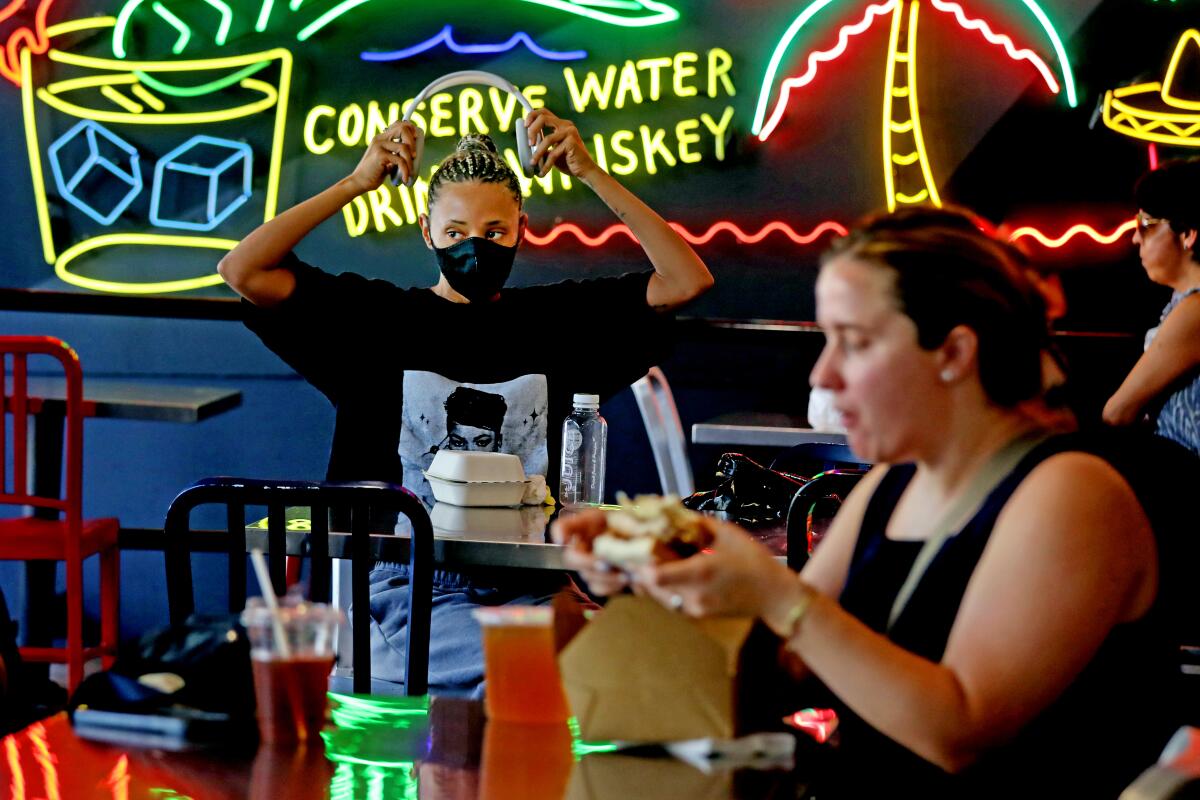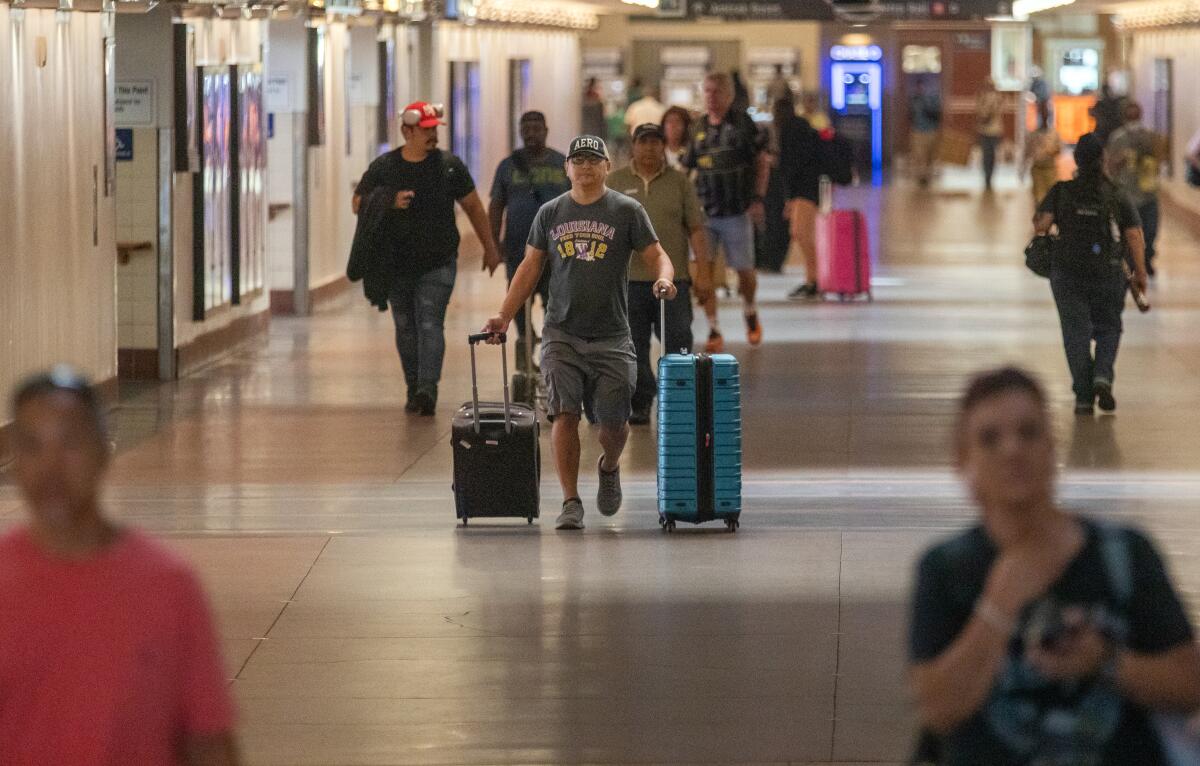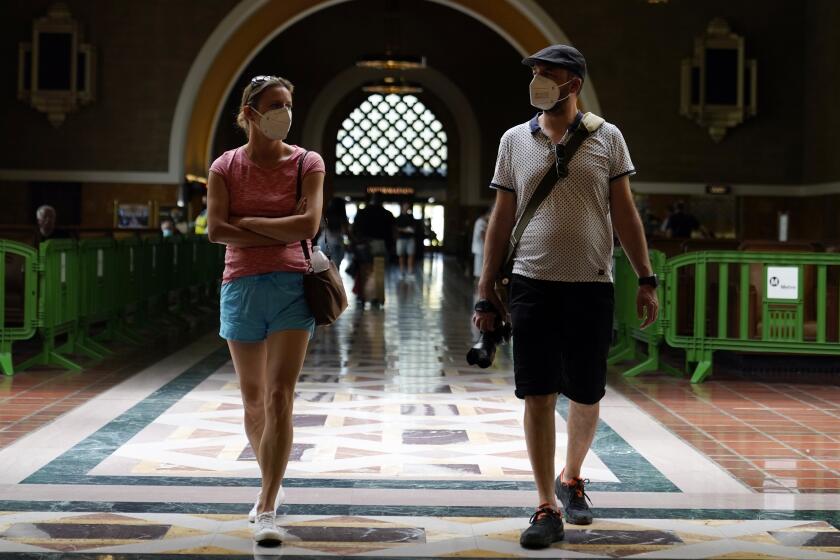California’s COVID comeback intensifies, but officials say there’s no cause for alarm

- Share via
Outbreak investigations. Disrupted work schedules. Canceled vacations. Wearing masks.
Sound familiar?
COVID-19 is making a comeback in California. Coronavirus levels in wastewater are on the rise in the state’s most populated areas, and hospitalizations continue to tick upward as residents return from trips and head back to school.
The latest rebound, seen both in public health data and at-home tests, has led some to question what — if any — new measures they should consider taking to protect themselves. With Labor Day weekend right around the corner, some may wonder whether they should scale back or alter their plans.
While residents should be aware of current trends, and the steps they can take to reduce their risk of infection, the higher transmission rates aren’t “a cause for alarm,” Los Angeles County Public Health Director Barbara Ferrer said.

“We want everyone to enjoy this last weekend of the summer, and we think this can be easily done with some simple basic safety measures,” she said.
Such steps are taking on increasing importance given the first sustained COVID flare-up in months.
Experts say travel, the back-to-school season and new Omicron subvariants are the likely reasons why coronavirus cases are continuing to rise locally and across the nation.
Coronavirus levels have more than doubled in Los Angeles’ wastewater since the start of summer, state data show, although they remain less than half of last winter’s peak. The rate at which reported test results are coming back positive is also up, now at 13.2% across California; at the start of summer, it was around 4%.
“These higher rates of transmission, while they’re not a cause for alarm, they do translate to more outbreaks in L.A. County, across schools, work sites and healthcare facilities,” Ferrer said. “Unfortunately, this often means missed days of work, missed learning and increased risk for those who are most susceptible to severe illness.”

In L.A. County, as of Thursday, there were 128 outbreak investigations in which new cases have appeared in the last four weeks. Eighty-six were in healthcare or community care settings, 20 in workplace settings, 12 in educational settings — including the L.A. Unified School District headquarters — five at sites serving people experiencing homelessness and five at correctional/detention facilities.
A number of work sites in the entertainment industry have experienced outbreaks recently, including the Directors Guild of America in Los Angeles, “The Masked Singer” studio at Red Studios Hollywood, Lionsgate Entertainment in Santa Monica and Walt Disney Feature Animation in Burbank, according to the county’s public health department.
People with COVID-19 are asked to stay home for at least five days after their first symptoms or their first positive test, whichever comes first.
The California Department of Public Health calculates that for every 100 people with the coronavirus in the state, 118 others are being infected by them, the highest transmission rate all summer.
During a news conference, the first held in months after what she acknowledged has been a “relatively calm summer,” Ferrer struck a largely calming tone. Coronavirus spread, though increasing, is nowhere near as far-reaching or disruptive as during the pandemic’s earlier phases.
Over the last week, Ferrer said, L.A. County has reported an average of about 571 new coronavirus cases a day — essentially double the figure from a month ago.
“Case numbers are relatively low compared to many other points this past year,” she said. “I also want to note that it’s a bit unfair to make those comparisons because there’s less reportable testing.”
Official case tallies have long been an undercount because of the prevalence of at-home testing, and that gap has only widened as public health departments wind down their screening efforts.
With coronavirus transmission on the rise, the FDA said this year’s updated version of the COVID-19 vaccine is likely to come out by the middle of next month.
Though the rise in infections is also accompanied by an increase in hospitalizations, the latter does not appear to be climbing at a rate comparable to past surges.
New weekly COVID-19 hospitalizations in California have doubled since the beginning of summer but remain less than half of last summer’s peak — possibly because of enduring immunity from past vaccinations or infections.
Nationally, new weekly COVID-19 hospitalizations are more than double since the start of the summer, but only one-third of last summer’s peak.
The dramatic decrease in severe illness and hospitalization explains why there is little appetite for tactics such as universal mask-wearing orders, the last of which ended in Los Angeles County 18 months ago. Even mask-wearing requirements for healthcare workers have ended in recent months; most California counties dropped the requirement in April, and L.A. County ended its order on Aug. 11.
Masking orders at certain sites, such as workplaces, have been ordered specifically to quell an outbreak. Some hospitals have returned to mask mandates; Kaiser Permanente Santa Rosa recently imposed one for hospital employees in response to the latest increase in coronavirus infections.
“The immunity is stronger today than at any other point in the outbreak,” Dr. Mandy Cohen, the director of the U.S. Centers for Disease Control and Prevention, said in a recent video briefing. “That means we’re moving toward COVID-19 being a more manageable illness with less severe illness.”
Compared to last summer, “we’re in a much different and better place in August of 2023,” Cohen said. “We have stronger immunity and tools to protect ourselves: We have vaccines, at-home tests, effective treatments and common-sense strategies like washing your hands and staying away from people when you’re sick.”
She added: “However, COVID-19 remains riskier if you’re unvaccinated, and riskier still if you are unvaccinated and [have] not had COVID as a prior infection. Your age and your underlying health conditions also matter.”
Amid the latest coronavirus uptick in California, health officials reiterate the same advice: Masks work, but it’s a personal preference whether to wear them.
The rise in infections illustrates the importance of getting the newly updated COVID-19 vaccine as soon as it becomes available, possibly by mid-September if authorized as expected by federal authorities. The vaccine will be especially important for older people.
For the record:
1:27 p.m. Sept. 1, 2023An earlier version of this article stated those most at risk for hospitalizations associated with COVID-19 are older people who are current on their vaccinations. Those most at risk are older people who are not up-to-date on their vaccinations.
About 70% of COVID-19 hospitalizations are among those 65 and older, Cohen said. Those most at risk continue to be older people who are not current on their vaccinations. At least 45,000 COVID-19 deaths have been recorded nationally this year.
Immune protection from COVID-19 “does decrease over time. And we have to remember that the COVID virus continues to change,” Cohen said. And with mutations constantly keeping scientists watchful, “people need to make sure that they’re staying up to date on their COVID vaccines.”
For people who have never been vaccinated, and for some older residents and those at higher risk, it might be better to get the existing vaccine now and not wait for the newer version, Cohen said.
Still, getting the older shot now could delay a person’s ability to get the new shot. Patients should talk to their healthcare providers for individual advice.
People can get a COVID-19 vaccination and a flu shot at the same time. Generally, everyone 6 months and older should get an annual flu shot, officials say; the best time is in September and October.
This year’s COVID-19 vaccine, which will be reviewed at a CDC advisory committee meeting on Sept. 12, is designed against the Omicron subvariant XBB.1.5, unofficially known as Kraken.
Officials have been closely watching another upstart Omicron subvariant, BA.2.86, nicknamed Pirola. Not many cases have been identified in the U.S., but there is concern it could be more capable of causing infection in people who previously have had COVID-19. More study is needed.
Studies are still underway to evaluate the effectiveness of the forthcoming vaccine, according to a risk assessment by the CDC, although it is expected to remain “effective at reducing severe disease and hospitalization.”
Health experts continue to advise taking reasonable precautions to avoid COVID-19 infection. Though most people no longer wear masks routinely, some officials say that masking up in the highest-risk settings, such as on public transit and while boarding and exiting an airplane, can make a difference.
Developing long COVID remains a risk with every infection, although it is likely reduced by being vaccinated and taking anti-COVID drugs such as Paxlovid soon after infection.
“COVID 19 is still changing, and we can’t accurately predict what will happen this fall,” Ferrer said. “What we do know is how to be prepared to take appropriate safety precautions as needed to protect ourselves and our community. This helps us minimize disruptions at schools and workplaces associated with more spread of the virus.”
More to Read
Sign up for Essential California
The most important California stories and recommendations in your inbox every morning.
You may occasionally receive promotional content from the Los Angeles Times.


















